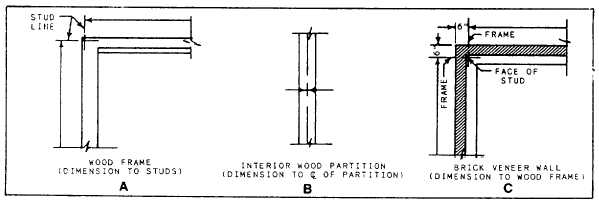checking rooms, closets, bathrooms, corridors,
and so on, as you proceed. Notice that a wider
wall is required to allow room for a plumbing pipe
to be contained within the wall.
2. Locate all doors. Both exterior and interior
doors can be drawn easily if you use an archi-
tectural template. Notice that exterior doors in
residential houses generally swing inward, whereas
those of commercial buildings are often required
by building or fire codes to swing outward.
Some people prefer a full or 90-degree door swing
over the 30-degree swing because they can check
to be certain that it will not interfere with
any equipment, walls, or appurtenances in the
room.
3. Draw in and locate all windows, using
proper window symbols and conventions. Next,
draw the stairs (and handrails, if any) and other
exterior and interior features, fixtures,
equipments, appliances, and cabinets, using their
proper symbols.
4. Lay out the guidelines for dimensions and
the dimension lines. Now that the building basic
floor plan is lightly laid out, double-check and
review the accuracy and completeness of the
information drawn in. You are now ready to
darken in the plan. Remember that, other
than the construction lines (which need not
be erased), all of the lines must be drawn darkly
and will vary only in the width of their lines.
As an EA, you must develop a systematic
approach in pursuing a fast and orderly darkening
of lines. Darkening from left to right and
then from top to bottom is common practice.
To help keep the drawings clean, EAs often
cover a partial section of their finished drawing
with a clean sheet of paper while darkening the
exposed section.
5. Draw in section markings on the floor plan
and indicate where the wall sections have been
taken. If at this point neither the section nor detail
markings have been decided upon, they may be
placed on the plan later. Complete the drawing
by adding all the material symbols, title, graphic
scale, and other relative information. Go over
your floor-plan checklist for completeness.
One of your challenges as an EA (and a
measure of drafting competency) is to apply your
dimensioning technique to the various types of
materials and construction methods used on the
building. Although the principles of dimensioning
and general locations of dimensions are the same,
a difference exists in which dimensions are shown,
and how the walls, openings, and partitions are
dimensioned.
DIMENSIONING A FLOOR PLAN.— Gen-
erally, dimensions should be laid out on sketch
paper before they are placed on the drawing.
Besides dimensions for interior partitions, as
many dimensions as possible are placed outside
the plan to avoid overcrowding. Moreover,
exterior dimensions are kept far enough away
from the plan to avoid interfering with roof
overhangs, notes, porches, or other features. In
DIMENSIONING FLOOR PLANS, proceed as
follows:
1. For wood-frame construction, locate the
extension line of the exterior wall dimension at
the outside face of the studs or stud line (fig.
10-14, view A). Partitions are measured from the
Figure 10-14.-Dimensioning wood-frame and veneer construction.
10-17

